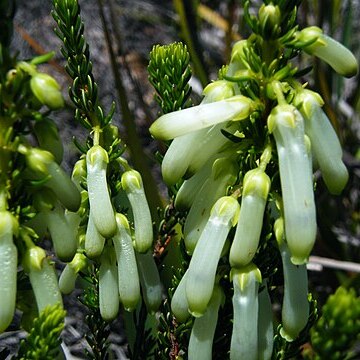Erect shrub up to 2 m (6 1/2 ft) or so. Branches ascending, densely leafy, glabrous. Leaves 6-nate or scattered, 4-14 mm long, erect-spreading or incurved, linear or subulate, acute or acuminate, often mucronate, glabrous or pubescent, ciliate or naked. Flowers generally in a dense, congested spike, thickening and persisting long after the fall of the corolla; peduncles very short. Bracts and sepals more or less similar, 3-6 mm long, closely adpressed and somewhat variable in shape from rhomboid, orbicular-spathulate or broad-ovate to unguiculate-spathulate (the lamina small, ovate, acute), oblanceolate and narrow-lanceolate, ciliate or naked, rarely lacerate, glabrous, scarious, nerved, pale-coloured or, at length, deep red. Corolla 1.6-3 cm long, usually 1-1.2 cm, clavate-tubular, mostly narrow at the base and widening above, rarely more equal, glabrous, dry, green to greenish-white or yellowish-green. Filaments slender, bent below the anther; anthers included or manifest, 1.3-2 mm long, lateral, subcuneate-oblong, prognathous at the base with a more or less sharp, deflexed point, appendiculate; pore about 1/2 the length of the cell; awns variable in length, usually shorter than the cell. Ovary turbinate, glabrous; style exserted; stigma capitate.
More
Erect, woody shrub, up to 2 m high. Leaves 6-nate or scattered, 4-14 mm long, linear, acute. Flowers in dense, congested spikes, persistent; pedicels short. Calyx sepals enlarging with age, narrowly lanceolate, rhomboid, broadly ovate, margins entire to serrate, glabrous, scarious, pale-coloured or deep red. Corolla 10-30 mm long, clavate-tubular, narrow at base widening above, glabrous, dry, green, greenish white or yellowish green. Filaments slender, bent below anther; anthers included or manifest, subcuneate-oblong, prognathous at base; pore ± 1/2 length of theca; appendages narrow, shorter than theca. Ovary turbinate; style exserted; stigma capitate. Flowering time all year. Fruit serotinous, fruiting synflorescences remaining on plant as cone-like structures, fruit protected by thickened calyces.
Erect, woody shrub to 2 m. Flowers large, tubular, light green, with distinctive fruiting inflorescences on older branches.
Can be grown by cuttings. Seeds needs stratification.

